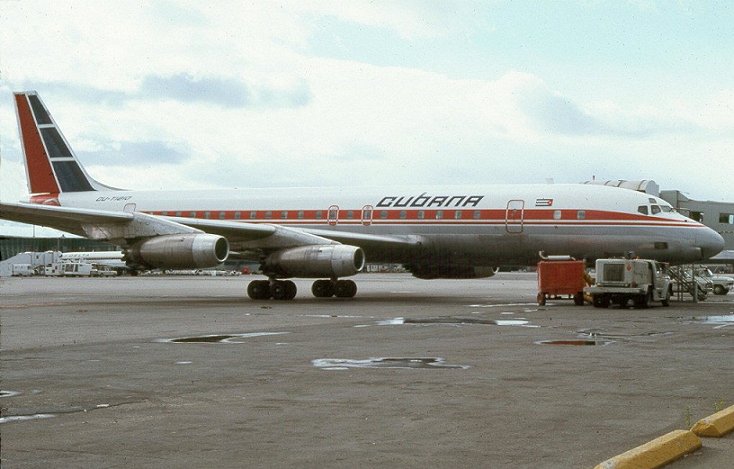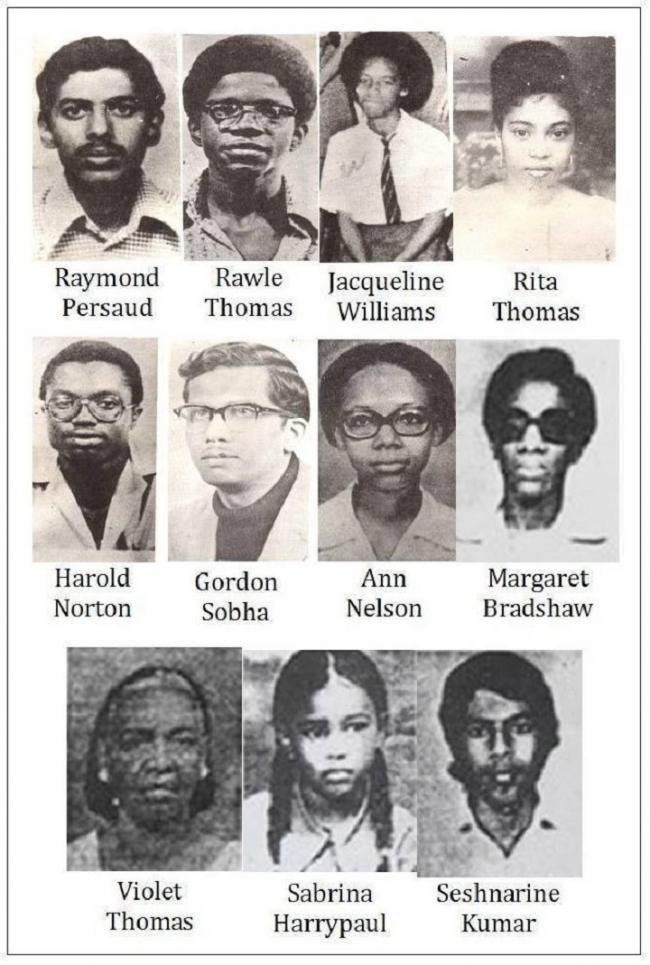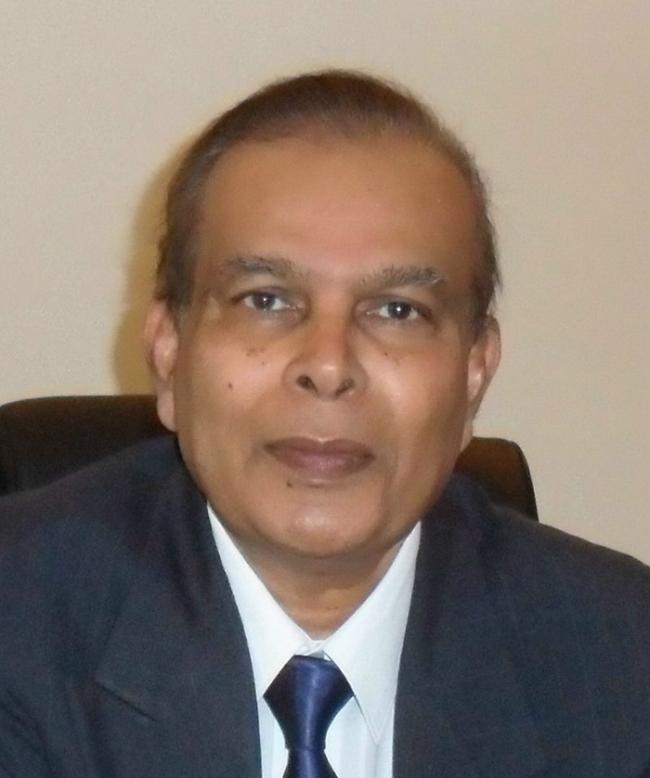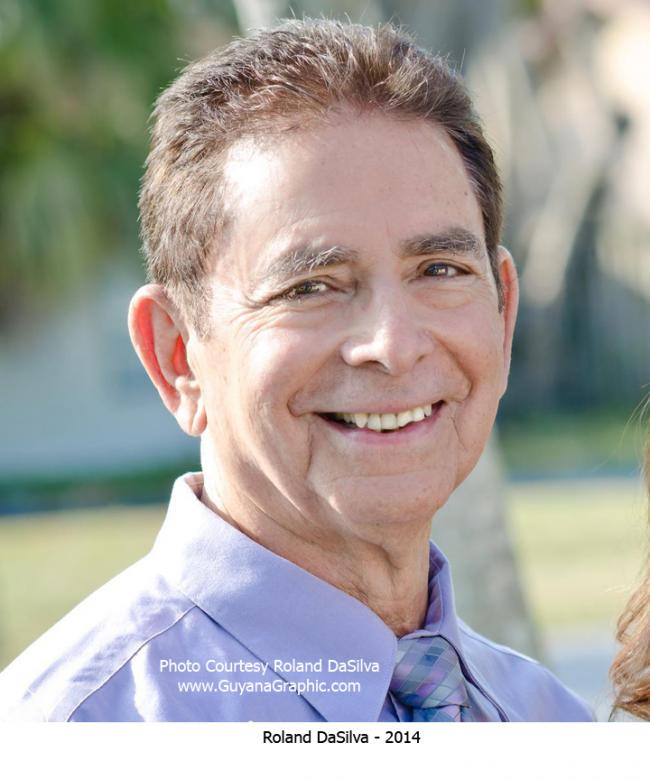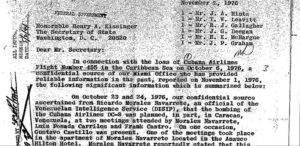
Cubana Flight 455 was a Cubana flight from Barbados to Jamaica that was brought down by a terrorist attack on October 6, 1976. All 73 people on board the Douglas DC-8 aircraft were killed in what was then the most deadly terrorist airline attack in the Western hemisphere. Two time bombs were used, variously described as dynamite or C-4. Evidence implicated several CIA-linked anti-Castro Cuban exiles and members of the Venezuelan secret police DISIP. Political complications quickly arose when Cuba accused the US government of being an accomplice to the attack. CIA documents released in 2005 indicate that the agency “had concrete advance intelligence, as early as June 1976, on plans by Cuban exile terrorist groups to bomb a Cubana airliner.” Former CIA operative Posada Carriles denies involvement but provides many details of the incident in his book “Caminos del Guerrero” (Way of the Warrior),
Four men were arrested in connection with the bombing and a trial was held in Venezuela: Freddy Lugo and Hernán Ricardo Lozano were sentenced to 20-year prison terms; Orlando Bosch was acquitted because of technical defects in the prosecution evidence, and now lives in Miami, Florida; and Luis Posada Carriles was held for eight years while awaiting a final sentence, but eventually fled. He later entered the United States, where he was held on charges of entering the country illegally but released on April 19, 2007.
On October 6, 1976, Flight CU-455 was scheduled to fly from Guyana to Havana, Cuba via Trinidad, Barbados, and Kingston.
At 17:24, nine minutes after takeoff from Barbados’s Seawell airport and at an altitude of 18,000 feet, a bomb located in the aircraft’s rear lavatories exploded. The captain, Wilfredo Pérez Pérez, radioed to the control tower: “We have an explosion aboard, we are descending immediately! … We have fire on board! We are requesting immediate landing! We have a total emergency!”
The plane went into a rapid descent, while the pilots unsuccessfully tried to return the plane to Seawell Airport. A second bomb exploded during the following minutes, causing the plane to crash. Realizing a successful landing was no longer possible, it appears that the pilot turned the craft away from the beach and towards the Atlantic Ocean, saving the lives of many tourists. This occurred about eight kilometres short of the airport.
All 48 passengers and 25 crew aboard the plane died: 57 Cubans, 11 Guyanese, and five North Koreans. Among the dead were all 24 members of the 1975 national Cuban Fencing team that had just won all the gold medals in the Central American and Caribbean Championship; many were teenagers.
Several officials of the Cuban government were also aboard the plane: Manuel Permuy Hernández, director of the National Institute of Sports (INDER); Jorge de la Nuez Suárez, secretary for the shrimp fleet; Alfonso González, National Commissioner of firearm sports; and Domingo Chacón Coello, an agent from the Interior Ministry.
The 11 Guyanese passengers included 18 and 19-year-old medical students, and the young wife of a Guyanese diplomat.
The five Koreans were government officials and a cameraman.
Hours after the explosions, Trinidad authorities arrested Freddy Lugo and Hernan Ricardo Lozano, two Venezuelan men who had boarded the plane in Trinidad and checked their baggage to Cuba but who had exited the plane in Barbados and flown back to Trinidad. Ricardo had been travelling with a false identity under the name of José Vázquez García.
Lugo and Ricardo confessed, and declared to be acting under the orders of Luis Posada Carriles. Their testimony, along with other evidence, implicated Posada and another Venezuelan, Orlando Bosch.
On 14 October 1976, Posada and Bosch were both arrested in Caracas, Venezuela and the offices of Investigaciones Comerciales e Industriales C.A. (ICICA), a private investigator’s company owned by Posada, were raided. Weapons, explosives and a radio transmitter were found. Ricardo was an employee of ICICA at the time of the attack, while Lugo worked as a photographer for the Ministry of Mines and Hydrocarbons.
On October 20, authorities of Trinidad, Cuba, Barbados, Guyana and Venezuela held a meeting in Port of Spain, during which the decision was taken to hold the trial in Venezuela, since the four accused were citizens of that country. Shortly after, Lugo and Ricardo were deported to Venezuela.
On August 25, 1977, Judge Delia Estava Moreno referred the case to a military tribunal, charging all four co-conspirators with treason.
In September 1980, a Venezuelan military judge acquitted all four men.
The prosecutor appealed, arguing that a military court was the wrong forum to try the case for two reasons: none of the men were military personnel in 1976, and the crime of qualified homicide or aggravated homicide cannot be tried by a military tribunal. The Military Court of Appeals agreed and surrendered jurisdiction, rendering the acquittal moot. The Judge ruled that the accused “are civilians and the crimes imputed to them are governed by the penal (and not the military) code… Civilians and common law crimes are not subject to the dispositions of the Code of Military Justice…”
The four were then charged with aggravated homicide and treason before a civilian court.
On August 8, 1985, Venezuelan judge Alberto Perez Marcano of the 11th Penal Court convicted Lugo and Ricardo, sentencing them each to 20 years in prison. The judge reduced the penalty to its lowest limit “due to the extenuating circumstance of no prior criminal records.” Orlando Bosch was acquitted, because the evidence gathered by the Barbados authorities during the investigation could not be used in the Venezuela trial, as it was presented too late and had not been translated into Spanish.
Posada fled from the San Juan de los Morros penitentiary on the eve of the pronouncement of his sentence. He had been confined in this prison following two previous failed escape attempts. Allegations were made that Venezuelan authorities were bribed to help him escape. No verdict was entered against Posada because, according to the Venezuelan Penal Code, judicial proceedings cannot continue without the presence of the accused. The court issued an arrest warrant against him which is still pending as of November, 2005.
A different judge then ordered the case reviewed by a higher court. The Venezuelan government declined to appeal the case any further, and in November 1987 Bosch was freed. He had spent 11 years in jail despite having been acquitted twice. Lugo and Lozano were released in 1993 and continue to reside in Venezuela.
Posada fled to Panama and then to the United States. In April 2005, a new warrant for Posada’s arrest in connection with the bombing was issued in Venezuela by the government of Hugo Chávez. However, a U.S. immigration judge ruled that Posada should not be deported to Cuba or Venezuela because he could be subject to torture in those countries. In 2007, Congressman Bill Delahunt and Jose Pertierra, an immigration lawyer representing the government of Venezuela, argued that Posada could be deported on the grounds that the U.S. was making an exception for Posada. Because, they argued, the U.S. practices extraordinary rendition involving the seizure and transportation of suspected terrorists to Syria and Egypt, both of which practice torture, the U.S. could also deport Posada, a terrorist, to Cuba or Venezuela.
Freed from Venezuelan charges, Bosch went to the United States, assisted by US Ambassador to Venezuela Otto Reich; there, he was ultimately arrested for a parole violation. Bosch was pardoned of all American charges by President George H.W. Bush on July 18, 1990 at the request of his son Jeb Bush, who later became Governor of Florida; this pardon came despite objections by the then President’s own defense department that Bosch was one of the most deadly terrorists working “within the hemisphere”. “Although many countries seek Bosch’s extradition he remains free in the United States. The political pressure to grant Bosch a pardon was begun during the congressional campaign run by Ileana Ros-Lehtinen, herself a Cuban American, and overseen by her campaign manager Jeb Bush.
In 2005, Posada was held by U.S. authorities in Texas on the charge of illegal presence on national territory before the charges were dismissed on May 8, 2007. His release on bail on April 19, 2007 had elicited angry reactions from the Cuban and Venezuelan governments. The U.S. Justice Department had urged the court to keep him in jail because he was “an admitted mastermind of terrorist plots and attacks”, a flight risk and a danger to the community.
On September 28, 2005 a U.S. immigration judge ruled that Posada cannot be deported because he faced the threat of torture in Venezuela.
Luis Posada Carriles, a Cuban-born naturalized Venezuelan, was the Director of Counterintelligence at Venezuela’s FBI equivalent, the DISIP, from 1967 to 1974. A U.S. Government document released through FOIA also confirms Posada’s status with the CIA: “Luis Posada, in whom CIA has an operational interest – Posada is receiving approximately $300 per month from CIA”. Posada was heavily involved with right-wing anti-Castro groups, in particular the Cuban-American National Foundation (CANF) and the Coordinadora de Organizaciones Revolucionarias Unidas (Coordination of United Revolutionary Organizations – CORU), led at the time by Orlando Bosch.
According to documents Posada stopped being a CIA asset in 1974, but that there remained “occasional contact” until June 1976, a few months before the bombing. CIA had concrete advance intelligence, as early as June 1976, on possible plans by Cuban exile terrorist groups to bomb a Cubana airliner, and the FBI’s attache in Caracas had multiple contacts with one of the Venezuelans who placed the bomb on the plane, and provided him with a visa to the U.S. five days before the bombing, despite suspicions that he was engaged in terrorist activities at the direction of Luis Posada Carriles.
A declassified CIA document dated October 12, 1976, a few days after bombing, quotes Posada as saying, a few days after a plate fund-raising meeting for CORU held around September 15, “We are going to hit a Cuban airliner… Orlando has the details” (Source Comment: The identities of “We” and “Orlando” were not known at the time.)
A declassified FBI document dated October 21, 1976, quotes CORU member Secundino Carrera as stating that CORU “was responsible for the bombing of the Cubana Airlines DC-8 on October 6, 1976… this bombing and the resulting deaths were fully justified because CORU was at war with the Fidel Castro regime.” Carrera also expressed his pleasure over the attention paid to the United States over the bombing, as it was taking attention off of himself and his associate.
Documents released by the National Security Archive on May 3, 2007 reveal the links Posada had to the 1976 Cubana airline bombing and other terrorist attacks and plots, including a British West Indian Airways office in Barbados and the Guyanese Embassy in Trinidad. These provide additional proof of Posada’s involvement in violent efforts to undermine Castro’s socialist government, said Peter Kornbluh, director of the National Security Archive’s Cuba Documentation Project. The Archive is an independent research organization located at George Washington University.
A monument was erected in Saint James, Barbados to the memory of the people killed in the bombing, and it was visited several times by Fidel Castro, including a visit during the CARICOM meeting in December 2005 during which Cuban officials called for Posada “to be brought to justice so as to bring closure to this egregious incident that caused so much pain to the people of the region.” In 2008 an additional monument to the tragedy is also under construction in Georgetown, Guyana. It is located at the junction of Camp and Lamaha streets.
Testimony before the House Foreign Affairs Subcommittee on International Organizations, Human Rights, and Oversight – November 15, 2007

